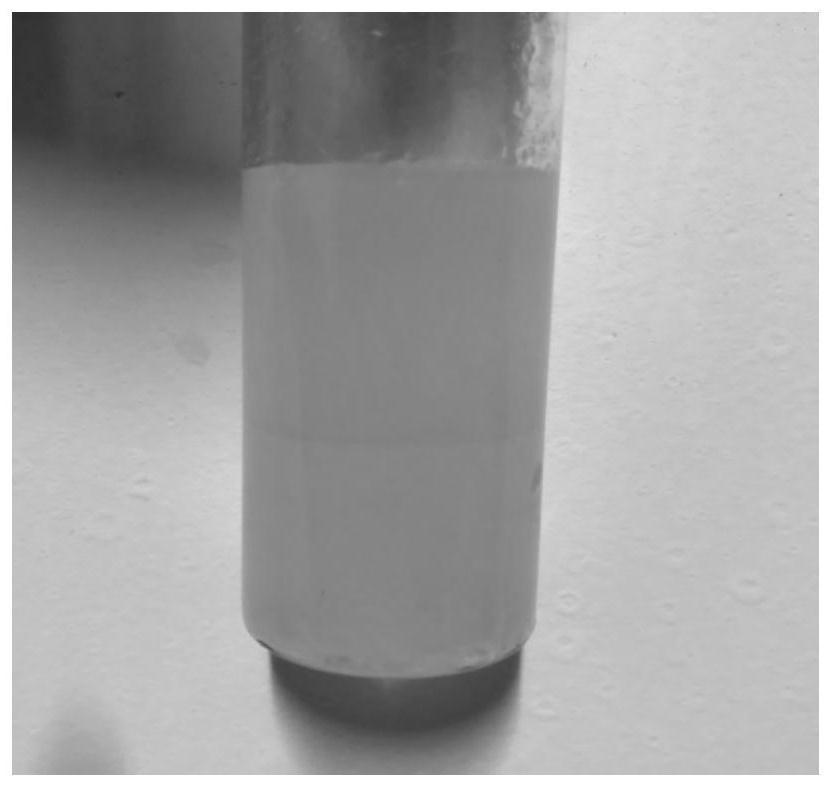Biphasic catalyst, preparation method thereof and application of biphasic catalyst in lignocellulose biomass conversion
A technology of lignocellulose and catalyst, applied in the conversion of lignocellulose biomass, two-phase catalyst and its preparation field, can solve the problems of a large amount of waste acid and alkali, equipment corrosion, harsh operating conditions, etc., and achieve equipment corrosion The effect of low cost, reduced processing cost, and low production cost
- Summary
- Abstract
- Description
- Claims
- Application Information
AI Technical Summary
Problems solved by technology
Method used
Image
Examples
Embodiment 1
[0044]Embodiments of the present invention provide a dual-phase catalyst, comprising a hydrophilic phase and a hydrophobic phase, wherein the hydrophilic phase is composed of tetrabutylammonium bromide and FeCl with a molar ratio of 3:1 3 ·6H 2 A deep eutectic solvent composed of O, and the hydrophobic phase is a deep eutectic solvent composed of tetraphenylammonium borate and capric acid in a molar ratio of 10:1.
[0045] The preparation method of above-mentioned biphasic catalyst comprises the steps:
[0046] Step a, according to design ratio, with 0.6mol tetrabutylammonium bromide and 0.2mol FeCl 3 ·6H 2 O mixed evenly, heated to 65°C, and stirred at constant temperature for 2 hours to obtain a uniform and transparent hydrophilic phase;
[0047] Step b, according to the design ratio, mix 0.5mol tetraphenylammonium borate and 0.05mol capric acid evenly, heat to 100°C, and stir at constant temperature for 2.5h to obtain a uniform and transparent hydrophobic phase;
[0048...
Embodiment 2
[0057] Embodiments of the present invention provide a dual-phase catalyst, comprising a hydrophilic phase and a hydrophobic phase, wherein the hydrophilic phase is composed of (1-butyl) triethylammonium bromide and FeCl with a molar ratio of 1:1 3 ·6H 2 A deep eutectic solvent composed of O, and the hydrophobic phase is a deep eutectic solvent composed of ammonium phosphomolybdate and capric acid with a molar ratio of 5:1.
[0058] The preparation method of above-mentioned biphasic catalyst comprises the steps:
[0059] Step a, according to design ratio, with 0.6mol (1-butyl) triethyl ammonium bromide and 0.6mol FeCl 3 ·6H 2 O mixed evenly, room temperature 25 ° C, constant temperature stirring for 3 hours, to obtain a uniform and transparent hydrophilic phase;
[0060] Step b, according to the design ratio, mix 0.2mol ammonium phosphomolybdate and 0.04mol capric acid evenly, and stir at a room temperature of 25°C for 5 hours at a constant temperature to obtain a uniform an...
Embodiment 3
[0066] Embodiments of the present invention provide a dual-phase catalyst, comprising a hydrophilic phase and a hydrophobic phase, wherein the hydrophilic phase is composed of tetrapropylammonium bromide and FeCl in a molar ratio of 6:1 3 ·6H 2 A deep eutectic solvent composed of O, and the hydrophobic phase is a deep eutectic solvent composed of cetyltrimethylammonium bromide and capric acid in a molar ratio of 4:1.
[0067] The preparation method of above-mentioned biphasic catalyst comprises the steps:
[0068] Step a, according to design ratio, with 0.6mol tetrapropyl ammonium bromide and 0.1mol FeCl 3 ·6H 2 O mixed evenly, heated to 68°C, and stirred at constant temperature for 2.5h to obtain a uniform and transparent hydrophilic phase;
[0069] Step b, according to the design ratio, mix 0.2mol cetyltrimethylammonium bromide and 0.05mol capric acid evenly, heat to 75°C, and stir at constant temperature for 3.0h to obtain a uniform and transparent hydrophobic phase;
...
PUM
 Login to view more
Login to view more Abstract
Description
Claims
Application Information
 Login to view more
Login to view more - R&D Engineer
- R&D Manager
- IP Professional
- Industry Leading Data Capabilities
- Powerful AI technology
- Patent DNA Extraction
Browse by: Latest US Patents, China's latest patents, Technical Efficacy Thesaurus, Application Domain, Technology Topic.
© 2024 PatSnap. All rights reserved.Legal|Privacy policy|Modern Slavery Act Transparency Statement|Sitemap


